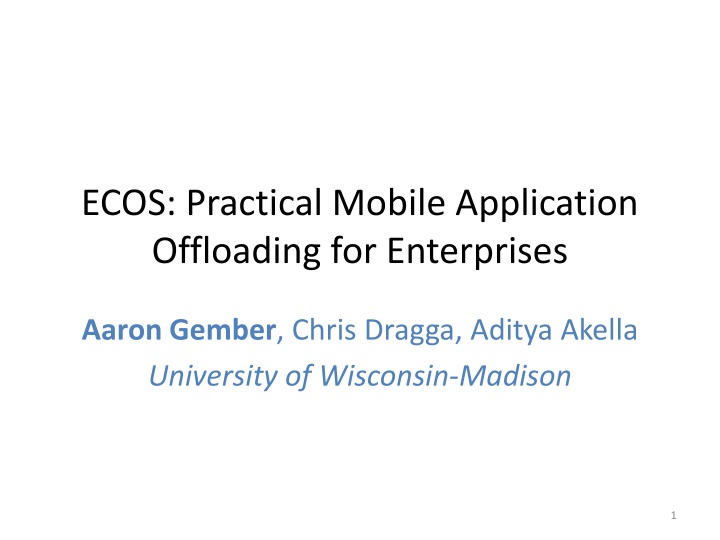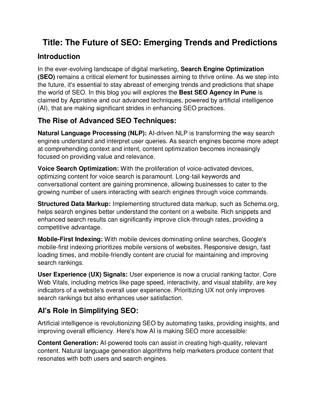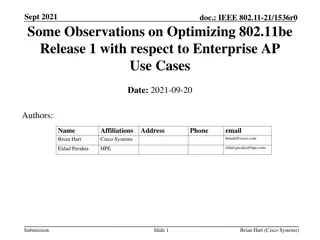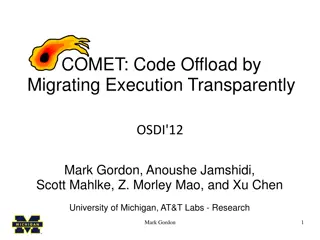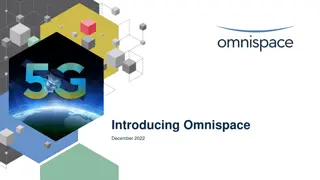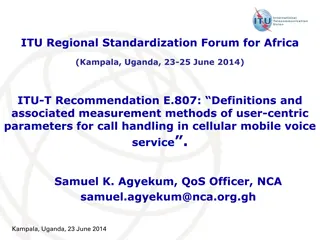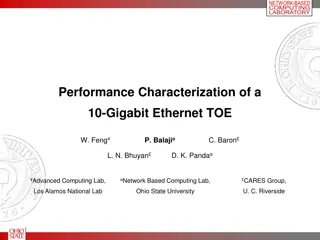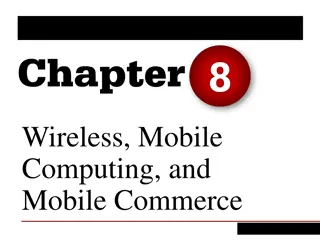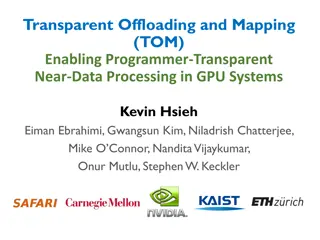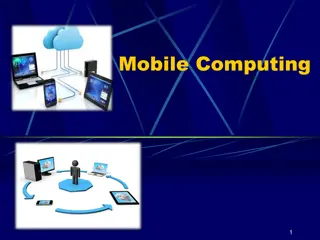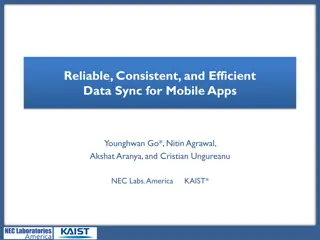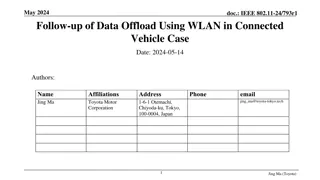Enterprise-Centric Offload System for Mobile Applications
This research explores the challenges and opportunities of offloading mobile application tasks to external compute resources in enterprises. Addressing privacy concerns, resource sharing dynamics, and the need for efficient offloading decisions, the Enterprise-Centric Offload System offers a practical approach for optimizing mobile application performance.
Download Presentation

Please find below an Image/Link to download the presentation.
The content on the website is provided AS IS for your information and personal use only. It may not be sold, licensed, or shared on other websites without obtaining consent from the author.If you encounter any issues during the download, it is possible that the publisher has removed the file from their server.
You are allowed to download the files provided on this website for personal or commercial use, subject to the condition that they are used lawfully. All files are the property of their respective owners.
The content on the website is provided AS IS for your information and personal use only. It may not be sold, licensed, or shared on other websites without obtaining consent from the author.
E N D
Presentation Transcript
ECOS: Practical Mobile Application Offloading for Enterprises Aaron Gember, Chris Dragga, Aditya Akella University of Wisconsin-Madison 1
Mobile Device Trends More mobile device usage in enterprises Need to run complex applications Complex mobile applications have significant CPU, memory, and energy demands Need to reconcile application demands and device capabilities 2
Designing for Remote Computation Mobile apps designed to use remote services e.g., Google Voice Search, Apple s Siri, Amazon Silk Requires developers to use this paradigm Remote desktop / VNC User interface not designed for mobile devices 3
Application-Independent Offloading Dynamically divide execution between mobile device and compute resource Application code unmodified Informed by model and/or runtime monitoring Several proposed systems Chroma [Balan et al. 2003], MAUI [Cuervo et al. 2011], CloneCloud [Chun et al. 2011] 4
Roadblocks to Offloading Adoption Privacy and trust Proposed systems largely ignore privacy Privacy is paramount in enterprises Resource sharing and churn Proposed systems consider one device, plus a dedicated resource Enterprises have many devices and many resources 5
Enterprise-Centric Offload System allows many devices to opportunistically leverage diverse compute resources, while controlling where applications offload depending on privacy, performance, and energy constraints of users and apps. Augment offloading decisions with privacy and resource considerations 6
Outline Offloading benefits and roadblocks Privacy and trust Resource sharing and churn ECOS Prototype Evaluation for small enterprise 7
Privacy and Trust Data may leave device without explicit actions Sufficient privacy requires Protecting execution state in transit Executing on trusted compute resources Offloading benefits and opportunities should not be significantly diminished 8
Overhead of Privacy Protection Encrypting state in transit with TLS High latency and energy overhead Limited number of trusted compute resources Reduced offloading opportunities 9
Data-Driven Privacy Protection Data Privacy Resources Trusted Communication Protection None Any None All internal resources Select servers and desktops Enterprise None User Encrypt always Policy specifies labels for devices & applications 10
Resource Sharing and Churn Systems consider one device and static resource Enable many mobile devices to opportunistically leverage diverse compute resources Challenges Devices with varying applications and objectives Limited resources and diverse capabilities Offload requests not know a priori 11
One-to-One Scheduling Each offload assigned a dedicated resource Dedicated CPU capacity -> faster performance Fewer slots -> reduced offload opportunities More affected by trust constraints or reduced resource availability 12
Multiplexing Based on Objective Offloads with same objective use same resource Performance improvement Resources with unused CPU > mobile CPU speed Energy savings Separate from performance seeking offloads 13
Resource Affinity Use same resource for subsequent offloads Cache state less latency and energy overhead Assumes constant resource availability/capacity Resource not capable/available Deny offloads until capacity increases Assign a new resource, re-transfer or migrate state 14
Prototype 1110101011 0001101001 1101010110 15
Evaluation Small enterprise setting 12 phones (Android emulator) 4 to 6 desktops (2.4Ghz quad-core, 4GB RAM) Two applications AI-decision making (Chess) Speech-to-text (emulated) Varying objectives and privacy levels 16
Performance Improvement 400 350 300 250 Time (sec) 200 150 100 50 0 1 2 3 4 5 6 7 8 9 10 11 12 Phones No Offloading 4 Desktops 6 Desktops 17
Energy Savings 250000 200000 150000 Energy (mW) 100000 50000 0 1 2 3 4 5 6 7 8 9 10 11 12 Phones No Offload 4 Desktops 6 Desktops 18
Resource Allocation Efficiency 400 350 300 Time (sec) 250 200 150 100 50 0 P1 P2 P3 P4 P5 P6 P7 P8 P9 P10 P11 P12 Phones No Offloading One-to-One + Affinity Multiplexing No Affinity Multiplexing + Affinity 19
Summary & Future Work Enterprise-Centric Offloading System Considers privacy requirements/costs Resources assigned based on user goals Maximize latency and energy benefits Future Work Dynamic privacy label assignment Network path provisioning mobility, bandwidth Larger evaluation 20
